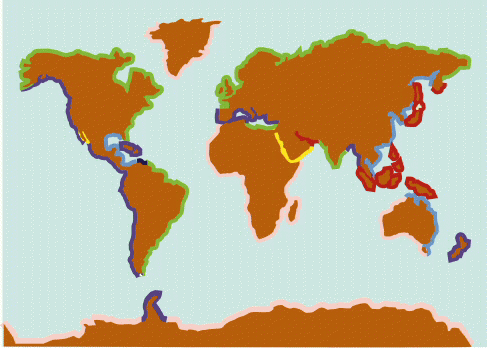|
|
Biology
561 Barrier Island Ecology Fall Semester, 2003 |
|
|
|
Eugene Delacroix (1798-1863) The Sea of Galilee, Walters Art Gallery, Baltimore, MD |
|
|
|
Biology
561 Barrier Island Ecology Fall Semester, 2003 |
|
|
|
Eugene Delacroix (1798-1863) The Sea of Galilee, Walters Art Gallery, Baltimore, MD |
|
Tectonic classification of coasts
 |
Collision plate margin coasts
Trailing margin coasts |
(redrawn from Inman, D. L. and Nordstrom. C. E. 1971. On the tectonic and morphologic classification of coasts. J. Geol. 79:1-21.)
Collision plate coasts
A collision plate coast typically lies along the edge of a convergent plate.
Collision plate coasts are often associated with earthquakes and volcanic activity.
These coasts are relatively straight with narrow continental shelves and steep continental slopes.
High mountains adjacent to the coast are potentially a significant source of sediment, but the narrow
continental shelf results in submarine canyon heads that lie close to shore.
As a result, most of the sediment deposited along the coast moves offshore through
canyons and thus into deeper water. Large deltas and barrier islands systems are
largely lacking on these narrow coasts.
There are two types of collision plate coasts:
| Continental collision plate coast: Continental coasts, such as the west coasts of North and South America, located along a collision boundary. | Island arc collision plate coast: A coast located along the collision margin of an island arc, such as New Guinea and Japan. |
Trailing plate margin coasts
This is a coast that faces a spreading center. The three categories of trailing
plate margin coasts:
| Neo-trailing plate margin coast: Coastline developed along the margin of a newly rifting land mass such as the Red Sea and the Gulf of California. | Amero-trailing plate margin coast: Trailing edge coast where the opposite side of the continent is a collision coast such as the east coasts of North and South America. The drainage and flow of sediment is from the collision plate side to the trailing margin coast | Afro-trailing plate margin coast: Trailing edge coast where the opposite side of the continent is also a trailing edge such as Greenland, Africa and Western Australia. |
Neo-trailing plate margin coasts are similar to collision plate margin coasts; volcanism and
earthquake activity are common along these coasts. The topography along
the coast is typically rugged and includes cliffs and/or mountains.
These relatively young, immature coastlines lack continental shelves.
Amero-trailing plate margin coasts possess large drainage systems with high sediment supplies.
These relatively old coastlines usually possess wide depositional continental shelves.
A relatively wide, flat coastal plain occurs landward of these coastlines.
Depositional features such as barrier islands, deltas, marshes, mangrove swamps, and tidal
flats are common.
Afro-trailing plate margin coasts are similar to amero-trailing edge coasts. Drainage basins are slightly smaller and sediment supply is less
producing narrower margins. Streams typically drain from the interior of the
adjacent land mass. Deltas and barrier islands are common features.
Marginal sea coasts
Marginal sea coasts occur in semi-protected environments including Eastern
Australia, the Gulf of Mexico and eastern Asian shorelines. The low wave
energy coasts of marginal seas are sheltered by nearby or surrounding land
masses, island arcs or ice. These coasts typically exhibit wide
continental shelves and are backed by hilly or low-lying regions.
Volcanism and earthquakes are uncommon.
| Glaeser, J. Douglas. 1978. Global distribution of barrier islands in terms of tectonic setting. J. Geol. 86:283-297. |
| 1.
Distribution of barrier islands along various coastal types a. Trailing plate margins (12% barrier islands) b. Collision plate margins (8% barrier islands) c. Marginal sea coasts (9.6% barrier islands) |
| 2.
Distribution of barrier islands based on total length of barrier islands a. Trailing marginsó49% b. Collision marginsó24% c. Marginal sea coastsó27% |
| 3.
Distribution influenced by: a. Sediment discharge from rivers 1) Data show no relationship between river sediment discharge and presence of barrier islands. 2) Most rivers are not currently building deltas, so there is no sediment source.
b.
Shelf width |
| 4.
Barrier island genesis and empirical data from existing distributions a. Modern surficial sands of the shoreface and inner shelf or headlands contribute to sediment building barrier islands. b. There is a close association between the existence and width of a low relief coastal plain and the presence of barrier islands. c. Along the China coast, low relief coastal plain is 25 km wide; in southeastern USA, 150-200 km wide. |
| 5.
Development and maintenance of barrier islands a. Broad, low gradient continental shelves and associated low relief coastal plains common to the trailing margins contain barrier island systems formed by mainland beach detachment (long-term features). b. Steep coasts with little or no coastal plain generally contain barrier island systems produced by coastwise spit progradation (short-lived features). |